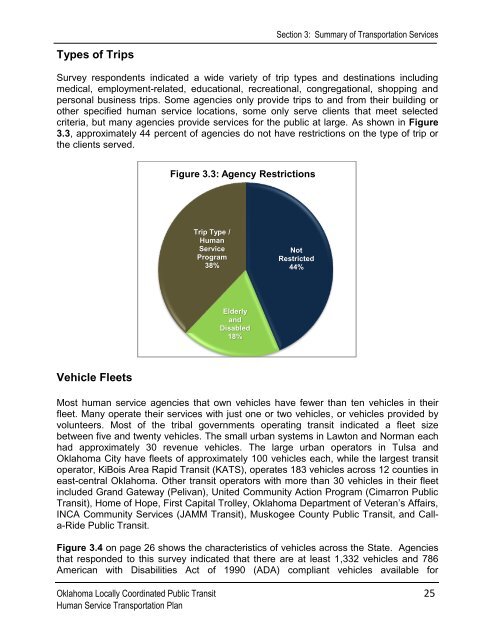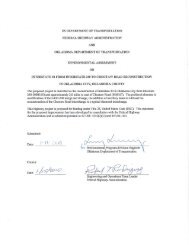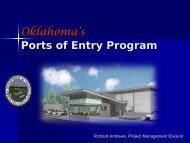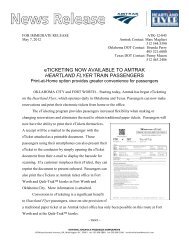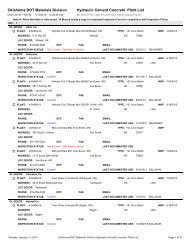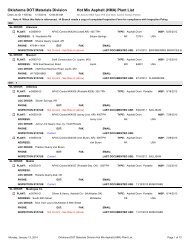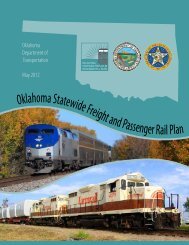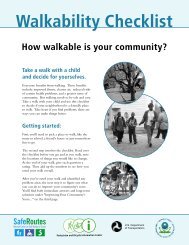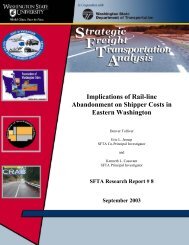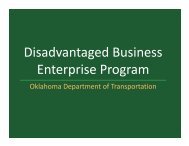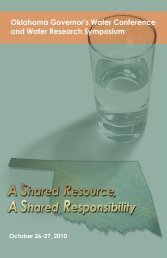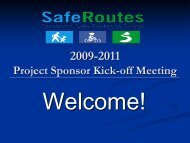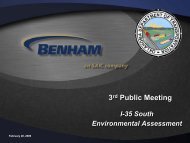JARC Coordination Plan - Oklahoma Department of Transportation
JARC Coordination Plan - Oklahoma Department of Transportation
JARC Coordination Plan - Oklahoma Department of Transportation
You also want an ePaper? Increase the reach of your titles
YUMPU automatically turns print PDFs into web optimized ePapers that Google loves.
Section 3: Summary <strong>of</strong> <strong>Transportation</strong> Services<br />
Types <strong>of</strong> Trips<br />
Survey respondents indicated a wide variety <strong>of</strong> trip types and destinations including<br />
medical, employment-related, educational, recreational, congregational, shopping and<br />
personal business trips. Some agencies only provide trips to and from their building or<br />
other specified human service locations, some only serve clients that meet selected<br />
criteria, but many agencies provide services for the public at large. As shown in Figure<br />
3.3, approximately 44 percent <strong>of</strong> agencies do not have restrictions on the type <strong>of</strong> trip or<br />
the clients served.<br />
Figure 3.3: Agency Restrictions<br />
Trip Type /<br />
Human<br />
Service<br />
Program<br />
38%<br />
Not<br />
Restricted<br />
44%<br />
Elderly<br />
and<br />
Disabled<br />
18%<br />
Vehicle Fleets<br />
Most human service agencies that own vehicles have fewer than ten vehicles in their<br />
fleet. Many operate their services with just one or two vehicles, or vehicles provided by<br />
volunteers. Most <strong>of</strong> the tribal governments operating transit indicated a fleet size<br />
between five and twenty vehicles. The small urban systems in Lawton and Norman each<br />
had approximately 30 revenue vehicles. The large urban operators in Tulsa and<br />
<strong>Oklahoma</strong> City have fleets <strong>of</strong> approximately 100 vehicles each, while the largest transit<br />
operator, KiBois Area Rapid Transit (KATS), operates 183 vehicles across 12 counties in<br />
east-central <strong>Oklahoma</strong>. Other transit operators with more than 30 vehicles in their fleet<br />
included Grand Gateway (Pelivan), United Community Action Program (Cimarron Public<br />
Transit), Home <strong>of</strong> Hope, First Capital Trolley, <strong>Oklahoma</strong> <strong>Department</strong> <strong>of</strong> Veteran’s Affairs,<br />
INCA Community Services (JAMM Transit), Muskogee County Public Transit, and Calla-Ride<br />
Public Transit.<br />
Figure 3.4 on page 26 shows the characteristics <strong>of</strong> vehicles across the State. Agencies<br />
that responded to this survey indicated that there are at least 1,332 vehicles and 786<br />
American with Disabilities Act <strong>of</strong> 1990 (ADA) compliant vehicles available for<br />
<strong>Oklahoma</strong> Locally Coordinated Public Transit 25<br />
Human Service <strong>Transportation</strong> <strong>Plan</strong>


